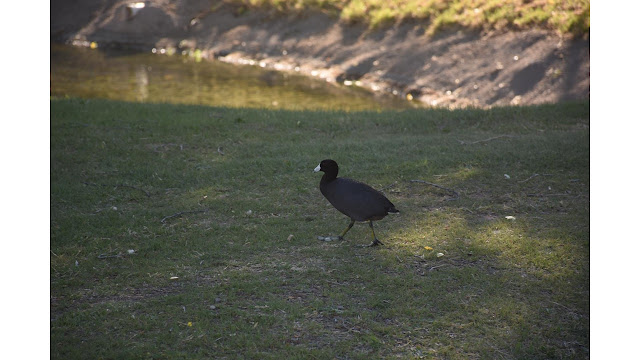
We made reservations to stay at Balmorhea State Park, in west Texas, which features San Solomon Springs. We didn't know what to expect. Driving through Texas, things didn't look too hopeful. It was dry. Real dry. If you look off in the far distance in this picture at the hazy mountains, that's where the campground was.
We got to our campsite, and things didn't look any too promising either. But wait...

a short walk later...and there are the springs.

This is a Civilian Conservation Corps project, which opened in 1936. The CCC was a federal "New Deal" program aimed at putting people to work when the US was trying to recover from the Great Depression. The CCC dug out the springs, lined the sides, and developed this incredible campground and recreation area.
This diagram from the park will look familiar to Water Resources Students. San Solomon Spring is an Artesian springs (one that is naturally flowing). It is fed from what's called a recharge area, which is often some distance from the spring, and always higher in elevation. The pressure due to that recharge water being higher than the spring causes the spring water to naturally rise, or even spray up. This cartoon shows how it works.
And this map shows the spring and the recharge area, which is in the mountains you saw in the second image above. The spring flows at about 15 million gallons a day and is the temperature of the gound it flows through, or 72 to 76 degrees year-round.
Before the CCC modified the spring, it was a Cienega, or desert wetland. The Texas Parks and Wildlife realized that the spring was critical habitat for several threatened and endangered animal species. So, in 1995, they created two new cienegas to make habitat similar to what was lost when the CCC built the original developed swimming area. The cienegas in the park is 3 acres, and there's another in town that's one acre. Here's how the cienegas in the park looks now, 22 years later. It was FULL of wildlife. If you go just a handful of feet to the side, it's dry, brown, stickery, and flat land.
American Coots like this one were utilizing the streams, canals, and wetland.
In this picture, you can see two kinds of turtles, the endangered Pecos Gambusia (fish), and a threatened native catfish only found in this area. There's another endangered fish, the Comanche Springs pupfish, which is found in the pool and canals.
They say a rolling stone gathers no moss, but apparently a swimming turtle can gather some algae on it's back. A punk turtle.
The campground was host to countless rabbits. Ok, I counted 19 once, but there were many more. Sophie was VERY interested. I was able to key this one out to "bunny rabbit," but I'd imagine John McDonald can tell you a bit more.
This always ticks me off. They're watering to make a lawn in the desert with water from the spring so folks can sunbathe. I'm not sure this is the highest and best use for this scarce resource, especially since a lot of it just landed on the sidewalk and evaporated. But we did see a lot of birds bathing in and drinking from the puddles formed.
Crazy.











Thanks for the great post on San Solomon Springs (in my early morning fog I saw the top picture and read the title as "Sans Salmon Springs" and was thinking, "why would there be salmon in Texas?!").
ReplyDeleteWell, they could be walking desert salmon :-)
ReplyDelete